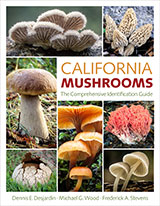The North American Species of Pholiota
189. Pholiota foedata (Pk.) comb. nov.
Hebeloma foedatum Pk., Bull. Torrey Bot. Club 22: 202. 1895.
Gymnopilus foedatus (Pk.) Murrill, North Amer. Fl. 10: 206. 1917.
Cortinarius foedatus (Pk.) Kauffman, Amer. Journ. Bot. 13: 28. 1926.
Illustrations: Text figs. 425-426.
Pileus 3.5-7.5 cm broad, convex, becoming plane or centrally depressed, reddish cinnamon, very viscid or glutinous, glabrous.
Lamellae emarginate and with a decurrent tooth, cinnamon colored, becoming mummy brown, medium broad, subcentricose, crowded.
Stipe 3.5-6.5 cm long, 4-8 mm thick, paler than the pileus, fibrillose, equal or slightly thickened at the base, solid.
Spores 6-7.5 x 4-4.5 µ, smooth, apical pore minute, wall up to 0.25-0.5 µ thick, shape elliptic to oval in face view, elliptic to very obscurely inequilateral in profile, in KOH rusty cinnamon and about the same color in Melzer's reagent.
Basidia 18-24 x 5-6 µ, 4-spored, clavate, yellowish-hyaline in KOH, yellowish in Melzer's reagent. Pleurocystidia abundant, 36-70 x 9-15 µ fusoid-ventricose, apex obtuse, wall thin and smooth in KOH but content at times reticulate-wrinkled and ochraceous in KOH as coagulated (often clearing on standing). Cheilocystidia similar to pleurocystidia or shorter and more fusoid, apex obtuse. Caulocystidia none found on type or on Sipe 248.
Gill trama a central strand of floccose hyphae not distinctively colored as revived in KOH, the walls thin and smooth; subhymenium a layer of hyaline branched gelatinous hyphae 2-3 µ diam. Pileus cutis a gelatinous pellicle of yellowish collapsed hyphae as revived in KOH; hypodermium of rusty brown hyphae 3-7 µ diam. with rusty colored incrustations. Context hyphae smooth and thin-walled, yellowish in KOH, hyphal cells greatly inflated. All hyphae inamyloid. Clamp connections present.
Habit, Habitat, and Distribution: Along streets, or among oak leaves. California (Pasadena). Type studied.
Observations: The type was from under oak in southern California and had adnexed gills. McClatchie's specimens which we have studied had dark reddish-rust colored spores much as in P. subangularis but in Sipe's 248 from conifer duff in the mountains they were paler. The gill color of McClatchie's material seen by us is now rusty cinnamon not a blackish brown (mummy brown). For these reasons the microscopic data and drawings are all taken from McClatchie's material. We suspect that when properly redescribed this species will be found to have other features than given in McClatchie's notes to distinguish it. There is no reason for referring the species to Cortinarius as Kauffman did, since the spores in the material studied by us were smooth. Kauffman in his notes, however, (unpublished) indicated that the spores were "under high power—roughish." This may have been an artifact, since his "high power" was a 3 mm dry objective, not an oil immersion lens. However, it cannot be denied that the possibility of a description based on two different species exists. If this can be proven the species should be abandoned as a source of confusion. At present, however, on the basis of the spore features it is possible to recognize it. The material we have studied is clearly a Pholiota.

